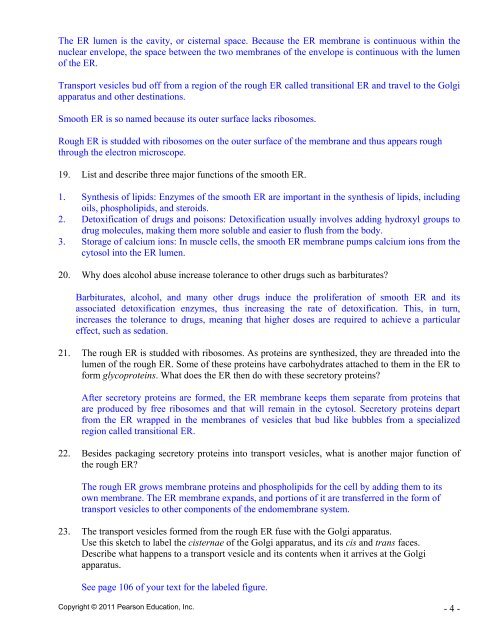You also want an ePaper? Increase the reach of your titles
YUMPU automatically turns print PDFs into web optimized ePapers that Google loves.
The ER lumen is the cavity, or cisternal space. Because the ER membrane is continuous within the<br />
nuclear envelope, the space between the two membranes of the envelope is continuous with the lumen<br />
of the ER.<br />
Transport vesicles bud off from a region of the rough ER called transitional ER and travel to the Golgi<br />
apparatus and other destinations.<br />
Smooth ER is so named because its outer surface lacks ribosomes.<br />
Rough ER is studded with ribosomes on the outer surface of the membrane and thus appears rough<br />
through the electron microscope.<br />
19. List and describe three major functions of the smooth ER.<br />
1. Synthesis of lipids: Enzymes of the smooth ER are important in the synthesis of lipids, including<br />
oils, phospholipids, and steroids.<br />
2. Detoxification of drugs and poisons: Detoxification usually involves adding hydroxyl groups to<br />
drug molecules, making them more soluble and easier to flush from the body.<br />
3. Storage of calcium ions: In muscle cells, the smooth ER membrane pumps calcium ions from the<br />
cytosol into the ER lumen.<br />
20. Why does alcohol abuse increase tolerance to other drugs such as barbiturates?<br />
Barbiturates, alcohol, and many other drugs induce the proliferation of smooth ER and its<br />
associated detoxification enzymes, thus increasing the rate of detoxification. This, in turn,<br />
increases the tolerance to drugs, meaning that higher doses are required to achieve a particular<br />
effect, such as sedation.<br />
21. The rough ER is studded with ribosomes. As proteins are synthesized, they are threaded into the<br />
lumen of the rough ER. Some of these proteins have carbohydrates attached to them in the ER to<br />
form glycoproteins. What does the ER then do with these secretory proteins?<br />
After secretory proteins are formed, the ER membrane keeps them separate from proteins that<br />
are produced by free ribosomes and that will remain in the cytosol. Secretory proteins depart<br />
from the ER wrapped in the membranes of vesicles that bud like bubbles from a specialized<br />
region called transitional ER.<br />
22. Besides packaging secretory proteins into transport vesicles, what is another major function of<br />
the rough ER?<br />
The rough ER grows membrane proteins and phospholipids for the cell by adding them to its<br />
own membrane. The ER membrane expands, and portions of it are transferred in the form of<br />
transport vesicles to other components of the endomembrane system.<br />
23. The transport vesicles formed from the rough ER fuse with the Golgi apparatus.<br />
Use this sketch to label the cisternae of the Golgi apparatus, and its cis and trans faces.<br />
Describe what happens to a transport vesicle and its contents when it arrives at the Golgi<br />
apparatus.<br />
See page 1<strong>06</strong> of your text for the labeled figure.<br />
Copyright © 2011 Pearson Education, Inc. - 4 -


